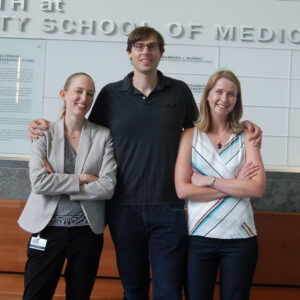A new generation of leaders
With the premature demise of Dr. Avioli in November 1999, leadership passed on to Roberto Pacifici, MD, on an interim basis until 2001 when Dwight A. Towler, MD, was appointed as the new division chief, a position he held for almost a decade.
Towler later moved on to a new endowed chair position at UT Southwestern Medical Center, Dallas, TX. Towler, a Washington University School of Medicine trainee, was interested in mechanisms of heterotopic calcification, and more recently, in valve and vascular calcification in arteriosclerosis and chronic kidney failure.
Under his leadership, the division continued its history of outstanding research contributions to the field of bone and mineral research, reinvigorated by the recruitment in 2001-2002 of research-oriented new investigators, namely Deborah Veis (Novack), MD, PhD, who focuses on the alternative NF-κB regulatory pathway in osteoclast-mediated bone loss and skeletal disease arising from arthritis and metastatic cancer, and more recently, on bone infections; and Fanxin Long, PhD, a developmental biologist interested in cell signaling in skeletal development and control of energy metabolism in osteoblast biology. After a transition to the Department of Orthopaedic Surgery, Long later moved to the University of Pennsylvania.
During a time of rapidly changing environment in the health care sector, the division continued to grow its clinical operations, and the Bone Health Program expanded its services to Barnes-Jewish West County Hospital, under the leadership of Kathryn Diemer, MD, who continues to function as its senior medical director.
Moving forward
In February 2010, Roberto Civitelli, MD, succeeded Towler as Chief of the Division of Bone and Mineral Diseases.

Under Civitelli’s leadership, the division has undergone a re-birth and substantial expansion of its research, teaching, and clinical operations.
Patient volumes and bone density services at the Bone Health Program have experienced double-digit growth for over a decade, and new clinicians have been recruited; including Carolyn Jachna MD; Naga Yalla, MD, and more recently, Mahshid Mohseni, MD, James Avery, MD, and Gary Gottesman, MD.
The constant growth in referrals and patient volumes led to further expansion of the Bone Health Program to a third site, in the Center for Advanced Medicine South County in mid-2016.
Likewise, the division research activities have expanded.
In 2010, Gabriel Mbalaviele, PhD, joined our faculty, after transitioning from an industry position, and developed a new line of research on the role of innate immunity in bone remodeling and disease.
A new NIH-funded Skeletal Disorders Training Program was established in 2011, and renewed in 2015, thus resuming a tradition of leadership in education and training in metabolic skeletal disorders.
In early 2012, the division laboratories and administrative offices moved to a new location, on the 11th floor of the BJC Institute of Health, along with the Orthopaedic Surgery research laboratory, in an interdisciplinary partnership that established a new Washington University Musculoskeletal Research Center.
In 2016, the division welcomed two new research faculty: Erica Scheller, DDS, PhD, who is interested in neuronal regulation of bone and the role of bone marrow fat; and Timothy Peterson, PhD, who studies genes that drive skeletal development, homeostasis, and response to therapy.
In 2017, the new Osteoporosis, Metabolic Bone Disorders Fellowship program was established, the first and still only full-fledged clinical training program in our specialty in the United States. One of the recent faculty recruits is a graduate of this program.

In 2019, an Adult Rare Bone Disease clinic was added as a new component of the Bone Health Program, conducted initially by Betsy Lin, MD, and now by Gary Gottesman, MD. This new clinic provides state-of-the-art clinical services to patients with genetically-based and rare disorders of the skeleton.
In 2022, the division celebrated growth and development. Dr. Kathleen Lowe joined our team, bringing fresh insights and expertise with her geriatric background that have been instrumental in advancing our clinical access. The same year, our efforts to enhance educational opportunities were bolstered by the renewal of our NIH T32 training grant. Additionally, we were able to hire our first two fellowship trainees, Drs. Mashid Mohseni and Elizabeth Lin. These appointments marked a pivotal expansion of our educational capacity and commitment to training the future leaders in bone and mineral diseases.
Moving forward, the Division of Bone and Mineral Diseases remains fully committed to carrying on the heritage, philosophy, and mission of its founder, building upon the enthusiasm, scientific curiosity, creativity, and outstanding expertise of its faculty and its clinical and technical staff.